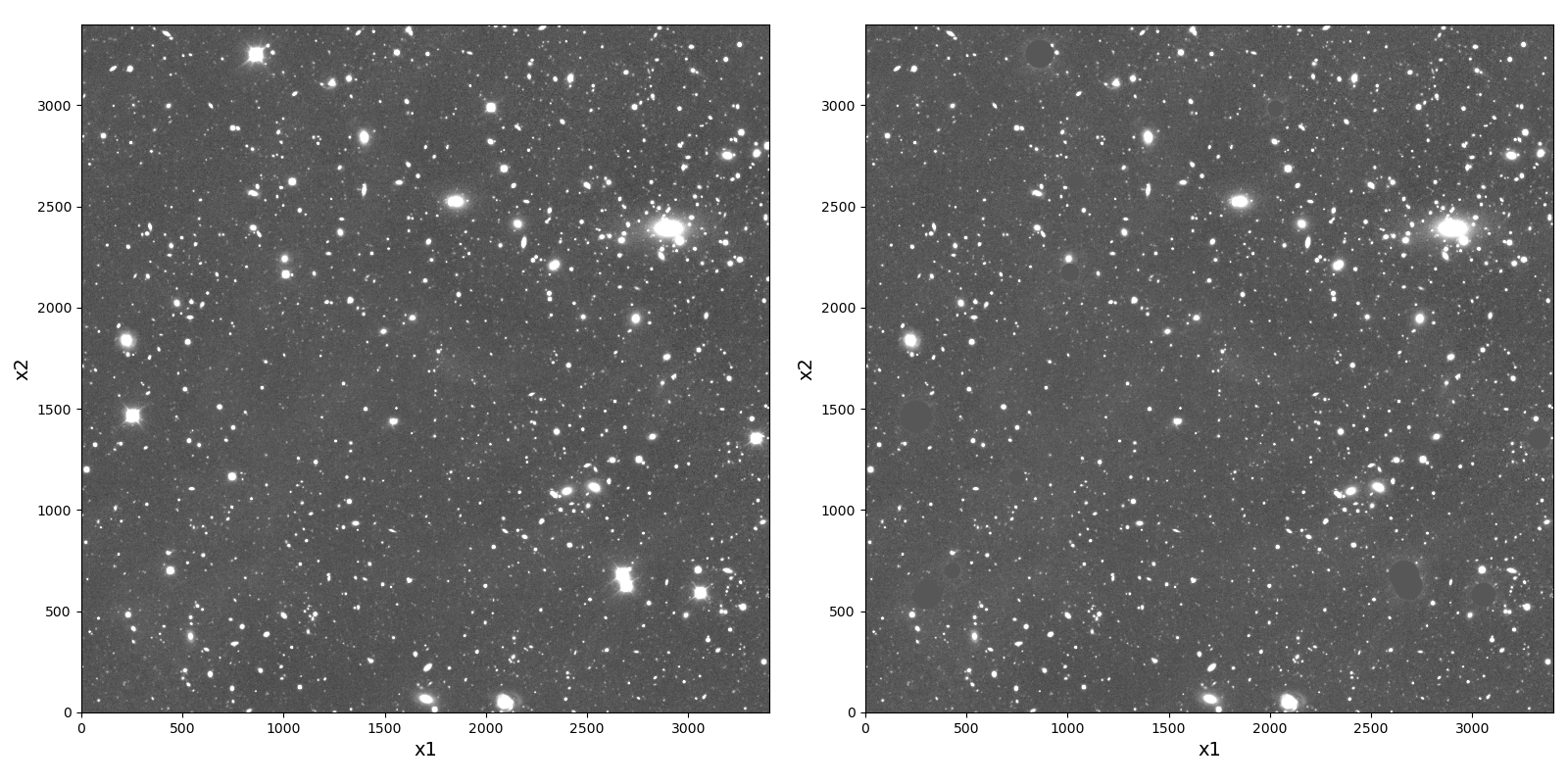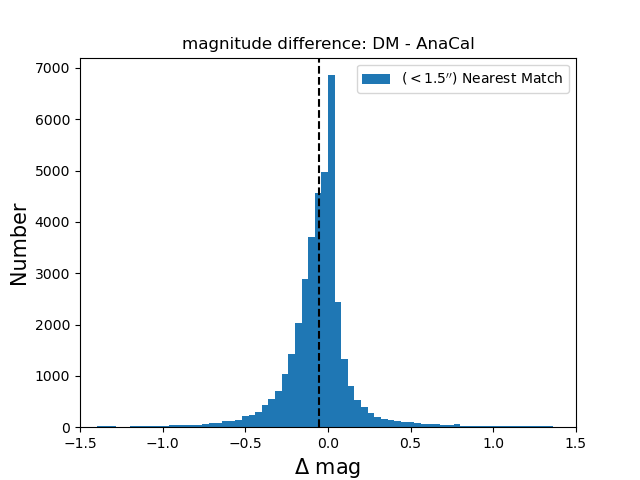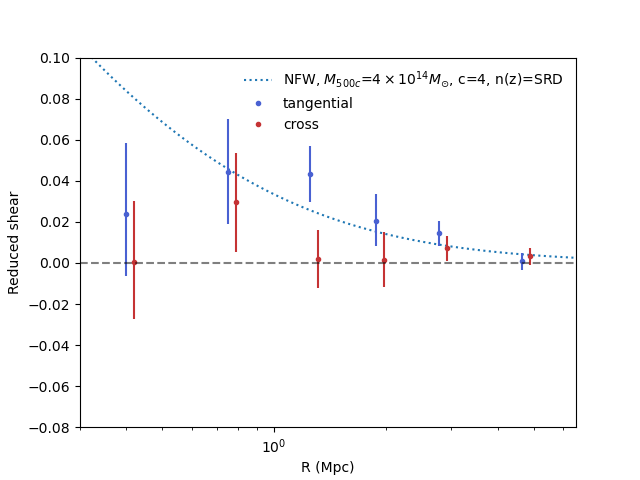SITCOMTN-164
AnaCal Shear Profile of Abell 360 in ComCam Data#
Abstract
This technote presents the measurement of the shear profile for the Abell 360 galaxy cluster using ComCam data processed with the AnaCal pipeline. We detail the procedures involved in bright star masking, source selection, and the estimation of tangential and cross shear around the cluster center. The resulting shear profiles provide key insights into the mass distribution of Abell 360 and demonstrate the capabilities of AnaCal in processing early LSST data.
Introduction#
The Rubin ComCam observing campaign conducted at the end of 2024 targeted seven fields, including the low ecliptic latitude Rubin SV 38 7 field. This field hosts the Abell 360 galaxy cluster, an intermediate-mass cluster at redshift \(z = 0.22\), which we use as a commissioning case study to demonstrate Rubin’s capabilities for weak lensing analyses of galaxy clusters.
This technote is one part of a series studying Abell 360 in order to both stress test the commissioning camera and demonstrate the technical capabilities of the Vera Rubin Observatory. We study the quality of the PSF modeling and impact it can have on cluster WL in Combet et al. [2025], implementation of cell-based coadds and subsequent use for Metadetect [Sheldon et al., 2023] in Gorsuch [2025], source selection of weak lensing galaxies in [Adari et al., 2025], photometric calibration in insert here, use of Anacal [Li et al., 2025] to produce a cluster shear profile in Li [2025], and background subtraction in this field and Fornax in insert here.
AnaCal Shear Estimation#
AnaCal is an analytical framework to derive the shear response of galaxy shape, flux, detection and selection processes, offering a precise and generalizable approach to characterizing how weak gravitational lensing affects measurements from astronomical images. Instead of relying on numerical shearing or image simulations, the method starts from first principles by analytically computing how each pixel value in an image responds to an applied shear after deconvolution and reconvolution with a Gaussian smoothing kernel [Li and Mandelbaum, 2023]. This pixel-level shear response captures the fundamental transformation properties of the image under lensing distortions.
Building on this, the framework then develops a way to propagate pixel-level shear responses to derived quantities—such as flux, moments, ellipticities, detection or selection—that are calculated as functions of the pixels. To do this systematically, the method introduces a mathematical formalism based on quintuple numbers [Li, 2025], a commutative ring to track shear response in the image processing. Each quintuple encodes not just the value of a quantity, but also its first-order derivatives with respect to shear, enabling propagation of shear responses through arbitrary differentiable algebraic operations.
To address noise bias, the method incorporates a “renoise” correction scheme. The idea is to construct a “renoised” image by adding a pure noise field—drawn from the same image noise distribution as the original image but rotated by 90 degrees. This rotation symmetrizes the noise contribution under shear distortion and allows the authors to analytically derive the correction term for noise bias in the shear response [Li et al., 2025]. The resulting correction is not only accurate but avoids the need for calibration of noise bias with external simulations, maintaining the fully analytical nature of the shear response pipeline.
Bright Star Mask#

Fig. 1 Coadd \(i\)-band image of tract 10463, patch 61, before (left) and after (right) masking the bright stars.#
To derive the pixel-level shear response following Li and Mandelbaum [2023], each coadd image is first deconvolved by its native PSF and then reconvolved with a Gaussian PSF using the Fast Fourier Transform (FFT). The target PSF size is set to be larger than the native PSF to ensure the image processing pipeline is stable. To prevent contamination from saturated pixels and artifacts around bright stars during the convolution, we mask these regions prior to processing. As illustrated in Fig. 1, saturated stars are masked and set to zero using circular regions, with the mask radius visually chosen to encompass both the saturated cores and surrounding artifacts.
AnaCal Shape Catalog#
The shape catalog was generated using xlens version v0.5.3, and the task along with its configuration is summarized below.
AnacalDetectTask:
class: xlens.process_pipe.anacal_detect.AnacalDetectPipe
config:
anacal.sigma_arcsec: 0.5
anacal.badMaskPlanes = [
"BAD",
"CR",
"CROSSTALK",
"NO_DATA",
"REJECTED",
"SAT",
"SUSPECT",
"UNMASKEDNAN",
"SENSOR_EDGE",
"STREAK",
"VIGNETTED",
"INTRP",
"EDGE",
"CLIPPED",
"INEXACT_PSF",
]
anacal.do_noise_bias_correction: True
The 1-sigma size of the target Gaussian PSF is set to \(0.5\) arcseconds, corresponding to a full width at half maximum (FWHM) of 1.16 arcseconds. In addition to masking regions near saturated bright stars, pixels flagged by any of the anacal.badMaskPlanes are set to zero prior to deconvolution to suppress artifacts.
The pipeline is run on \(i\)-band coadd images, beginning with a 5-sigma source detection performed after smoothing the image with the target Gaussian kernel. Flux and shape measurements are then carried out for each detected source.
For the results presented in this technote, we adopt the flux from Gaussian model fitting as the fiducial galaxy flux (denoted as \(F\)). For shape measurements (\(e_1\), \(e_2\)) and trace radius (\(M_2\)), we use the FPFS ellipticity and trace radius derived using fixed-kernel Shapelets [Li et al., 2018, Li et al., 2022, Park et al., 2025]. Each of these quantities has a corresponding shear response, denoted as \(\frac{\partial F}{\partial g_{1,2}}\), \(\frac{\partial e_{1,2}}{\partial g_{1,2}}\), and \(\frac{\partial m_2}{\partial g_{1,2}}\). The shear is then estimated by
Additionally, the AnaCal flux is defined as \(\textrm{mag} = Z - 2.5\log_{10}(F)\), where \(Z\) refers to the magnitude zero point.
The following selection is applied to the catalog to select bright, well-resolved galaxies
Column |
|---|
mag \(\leq\) 24 |
\(M_2\) \(\geq\) 0.05 |
The shear-dependent biases caused by the selection is estimated and corrected using the shear response of Gaussian flux and trace radius.
Match to DM catalog#

Fig. 2 Magnitude difference between DM (CModel) and AnaCal. Galaxies are, on average, 0.05 magnitudes fainter in AnaCal compared to DM measurements.#
To exclude member galaxies of Abell 360, we apply the same color and photometric redshift cuts as described in [Adari et al., 2025], following a cross-match between the AnaCal detections and the DM catalog. For each AnaCal detection, we identify the nearest DM galaxy and retain matches with separations less than \(1.5\) arcseconds. Fig. 2 shows the histogram of the magnitude differences between the CModel flux from the DM pipeline and the Gaussian flux from AnaCal. On average, galaxies appear approximately \(0.05\) magnitudes fainter in the AnaCal catalog, due to the Gaussian flux measurement capturing less of the total light compared to CModel.
Shear Profile#
The resulting shear profile is shown in Fig. 3. It is computed using galaxy shapes and their shear responses, binned into six evenly spaced radial bins spanning from 0.35 Mpc to 6.5 Mpc. The error bars represent 68% confidence intervals, estimated via bootstrap resampling within each radial bin, ordered from smallest to largest separation.

Fig. 3 The reduced shear profile around A360 for both tangential (blue) and cross (red) shear measurements, using the cuts described throughout the technote. Both measured profiles have 68% confidence intervals.#
The theoretical shear profile is generated using the Cluster Lensing Mass Modeling (CLMM) code [Aguena et al., 2021]. This model serves as a rough reference and is not fitted to the calibrated shear measurements. It assumes a Navarro-Frenk-White (NFW) halo with a cluster mass of \(M_{500c} = 4 \times 10^{14}, M_\odot\) [Hilton et al., 2021] and a concentration parameter of 4… The source redshift distribution is adopted from the LSST Dark Energy Science Collaboration’s Science Requirements Document (SRD) [The LSST Dark Energy Science Collaboration et al., 2018].
References#
Prakruth Adari, Anja von der Linden, Tianqing Zhang, Céline Combet, Anthony Englert, Shenming Fu, Narei Lorenzo Martinez, and Andrés A. Plazas Malagón. Source Selection for Abell 360 in LSSTComCam Data Preview 1. Commissioning Technical Note SITCOMTN-163, NSF-DOE Vera C. Rubin Observatory, July 2025. URL: https://sitcomtn-163.lsst.io/, doi:10.71929/rubin/2571157.
C. Combet, A. Plazas Malagón, S. Fu, P. Adari, I. Dell'Antonio, A. Englert, M. Gorsuch, K. Laliotis, P.-F. Léget, E. Pedersen, A. von der Linden, Y. Zhang, and et al. (TBC). PSF assessment in the field of Abell 360 and shapeHSM shear profile using LSSTComCam data. Commissioning Technical Note SITCOMTN-161, NSF-DOE Vera C. Rubin Observatory, July 2025. URL: https://sitcomtn-161.lsst.io/.
Miranda R. Gorsuch. Testing the implementation of Metadetection and Cell-Based Coadds on Abell 360 ComCam data. Commissioning Technical Note SITCOMTN-162, NSF-DOE Vera C. Rubin Observatory, July 2025. URL: https://sitcomtn-162.lsst.io/.
Xiangchong Li. AnaCal Shear Profile or Abell 360 in ComCam Data. Commissioning Technical Note SITCOMTN-164, NSF-DOE Vera C. Rubin Observatory, July 2025. URL: https://sitcomtn-164.lsst.io/.
M. Aguena, C. Avestruz, C. Combet, S. Fu, R. Herbonnet, A. I. Malz, M. Penna-Lima, M. Ricci, S. D. P. Vitenti, L. Baumont, H. Fan, M. Fong, M. Ho, M. Kirby, C. Payerne, D. Boutigny, B. Lee, B. Liu, T. McClintock, H. Miyatake, C. Sifón, A. von der Linden, H. Wu, M. Yoon, and LSST Dark Energy Science Collaboration. CLMM: a LSST-DESC cluster weak lensing mass modeling library for cosmology. \mnras , 508(4):6092–6110, December 2021. arXiv:2107.10857, doi:10.1093/mnras/stab2764.
M. Hilton, C. Sifón, S. Naess, M. Madhavacheril, M. Oguri, E. Rozo, E. Rykoff, T. M. C. Abbott, S. Adhikari, M. Aguena, S. Aiola, S. Allam, S. Amodeo, A. Amon, J. Annis, B. Ansarinejad, C. Aros-Bunster, J. E. Austermann, S. Avila, D. Bacon, N. Battaglia, J. A. Beall, D. T. Becker, G. M. Bernstein, E. Bertin, T. Bhandarkar, S. Bhargava, J. R. Bond, D. Brooks, D. L. Burke, E. Calabrese, M. Carrasco Kind, J. Carretero, S. K. Choi, A. Choi, C. Conselice, L. N. da Costa, M. Costanzi, D. Crichton, K. T. Crowley, R. Dünner, E. V. Denison, M. J. Devlin, S. R. Dicker, H. T. Diehl, J. P. Dietrich, P. Doel, S. M. Duff, A. J. Duivenvoorden, J. Dunkley, S. Everett, S. Ferraro, I. Ferrero, A. Ferté, B. Flaugher, J. Frieman, P. A. Gallardo, J. García-Bellido, E. Gaztanaga, D. W. Gerdes, P. Giles, J. E. Golec, M. B. Gralla, S. Grandis, D. Gruen, R. A. Gruendl, J. Gschwend, G. Gutierrez, D. Han, W. G. Hartley, M. Hasselfield, J. C. Hill, G. C. Hilton, A. D. Hincks, S. R. Hinton, S. -P. P. Ho, K. Honscheid, B. Hoyle, J. Hubmayr, K. M. Huffenberger, J. P. Hughes, A. T. Jaelani, B. Jain, D. J. James, T. Jeltema, S. Kent, K. Knowles, B. J. Koopman, K. Kuehn, O. Lahav, M. Lima, Y. -T. Lin, M. Lokken, S. I. Loubser, N. MacCrann, M. A. G. Maia, T. A. Marriage, J. Martin, J. McMahon, P. Melchior, F. Menanteau, R. Miquel, H. Miyatake, K. Moodley, R. Morgan, T. Mroczkowski, F. Nati, L. B. Newburgh, M. D. Niemack, A. J. Nishizawa, R. L. C. Ogando, J. Orlowski-Scherer, L. A. Page, A. Palmese, B. Partridge, F. Paz-Chinchón, P. Phakathi, A. A. Plazas, N. C. Robertson, A. K. Romer, A. Carnero Rosell, M. Salatino, E. Sanchez, E. Schaan, A. Schillaci, N. Sehgal, S. Serrano, T. Shin, S. M. Simon, M. Smith, M. Soares-Santos, D. N. Spergel, S. T. Staggs, E. R. Storer, E. Suchyta, M. E. C. Swanson, G. Tarle, D. Thomas, C. To, H. Trac, J. N. Ullom, L. R. Vale, J. Van Lanen, E. M. Vavagiakis, J. De Vicente, R. D. Wilkinson, E. J. Wollack, Z. Xu, and Y. Zhang. The Atacama Cosmology Telescope: A Catalog of >4000 Sunyaev-Zel\textquoteright dovich Galaxy Clusters. \apjs , 253(1):3, March 2021. arXiv:2009.11043, doi:10.3847/1538-4365/abd023.
Xiangchong Li. Analytical weak-lensing shear response of galaxy model fitting. arXiv e-prints, pages arXiv:2506.16607, June 2025. arXiv:2506.16607, doi:10.48550/arXiv.2506.16607.
Xiangchong Li, Nobuhiko Katayama, Masamune Oguri, and Surhud More. Fourier Power Function Shapelets (FPFS) shear estimator: performance on image simulations. \mnras , 481(4):4445–4460, December 2018. arXiv:1805.08514, doi:10.1093/mnras/sty2548.
Xiangchong Li, Yin Li, and Richard Massey. Weak gravitational lensing shear measurement with FPFS: analytical mitigation of noise bias and selection bias. \mnras , 511(4):4850–4860, April 2022. arXiv:2110.01214, doi:10.1093/mnras/stac342.
Xiangchong Li and Rachel Mandelbaum. Analytical weak-lensing shear responses of galaxy properties and galaxy detection. \mnras , 521(4):4904–4926, June 2023. arXiv:2208.10522, doi:10.1093/mnras/stad890.
Xiangchong Li, Rachel Mandelbaum, and The LSST Dark Energy Science Collaboration. Analytical noise bias correction for precise weak lensing shear inference. \mnras , 536(4):3663–3676, February 2025. arXiv:2408.06337, doi:10.1093/mnras/stae2764.
Andy Park, Xiangchong Li, and Rachel Mandelbaum. Accurate shear estimation with fourth-order moments. \mnras , 537(1):507–519, February 2025. arXiv:2411.13648, doi:10.1093/mnras/staf053.
Erin S. Sheldon, Matthew R. Becker, Michael Jarvis, Robert Armstrong, and LSST Dark Energy Science Collaboration. Metadetection Weak Lensing for the Vera C. Rubin Observatory. The Open Journal of Astrophysics, 6:17, May 2023. arXiv:2303.03947, doi:10.21105/astro.2303.03947.
The LSST Dark Energy Science Collaboration, Rachel Mandelbaum, Tim Eifler, Renée Hložek, Thomas Collett, Eric Gawiser, Daniel Scolnic, David Alonso, Humna Awan, Rahul Biswas, Jonathan Blazek, Patricia Burchat, Nora Elisa Chisari, Ian Dell'Antonio, Seth Digel, Josh Frieman, Daniel A. Goldstein, Isobel Hook, Željko Ivezić, Steven M. Kahn, Sowmya Kamath, David Kirkby, Thomas Kitching, Elisabeth Krause, Pierre-François Leget, Philip J. Marshall, Joshua Meyers, Hironao Miyatake, Jeffrey A. Newman, Robert Nichol, Eli Rykoff, F. Javier Sanchez, Anže Slosar, Mark Sullivan, and M. A. Troxel. The LSST Dark Energy Science Collaboration (DESC) Science Requirements Document. arXiv e-prints, pages arXiv:1809.01669, September 2018. arXiv:1809.01669, doi:10.48550/arXiv.1809.01669.